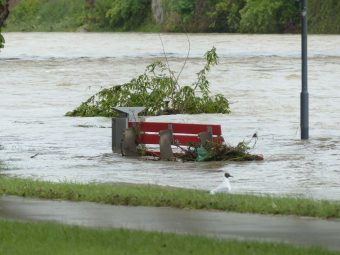
Severe storms in the south of England in 2013/14 were made more likely by human emissions of carbon dioxide. A new study says that climate change increased the chances of a once-in-a-century wet January in 2014 by 43%. Researchers were also able to estimate the climate impact on rainfall, river flow and properties at risk. Citizen scientists made key contributions to the study using their computers to run simulations of UK weather patterns. The winter of 2013/14 was marked by a near continuous line of severe storms that rolled across southern England and Wales. In Somerset, Devon, Dorset, Cornwall and the Thames Valley, the incessant rain lead to significant flooding. Some 5,000 homes and businesses were under water, and there were nearly 19,000 insurance claims with £451m in insured losses.
Warming suspected
At the time, many commentators suggested that climate change was having an influence on the scale of the storms and flooding. When asked about this in the House of Commons, Prime Minister David Cameron replied: “I very much suspect that it is”. UK researchers first presented evidence in April 2014 showing that climate change had increased the risk of flooding. This new study includes a much more detailed perspective, with estimates for the impact of climate change on river flow, levels of inundation and the number of properties at risk. The scientists used a range of models and observational data to try and work out the human influence. The research team asked citizen scientists from all over the world to use spare processing time on their computers to run over 130,000 simulations of what the weather would have been like with and without this human influence on the climate.
Human induced warming, they found, increased the capacity of the air to hold moisture but also caused a “small but significant” increase in the number of January days in the UK with westerly winds. “We found that extreme rainfall, as seen in January 2014, is more likely to occur in a changing climate,” said lead author Dr Nathalie Schaller, from the University of Oxford. “This is because not only does the higher water-holding capacity lead to increased rainfall, but climate change makes the atmosphere more favorable to low-pressure systems bringing rain from the Atlantic across southern England.” The team concluded that this increased the risk of a once-in-a-century wet January by 43%. They also found that the heightened risk of rainfall in the meteorological modelling, led to an increase in the peak 30-day river flow at Kingston-on-Thames of 21%, and they were able to use flood risk mapping to indicate that about 1,000 more properties being at the risk of flooding. “It is a small increase, but it is a robust increase,” said Dr Friederike Otto, another author, also from Oxford University. “It is not that a flood that has been a one in a hundred year event is now happening every three years, it is still that a once in a hundred years flood is now happening every 70 years.”
Uncertainty range
The researchers say that there are significant uncertainties in the range of their findings – The 43% figure for the increase in the risk of a once-in-a-century wet January is a best estimate in a range that runs from 0-160%. “We know relatively well what the weather in the world we live in is, we can model that and test the model against observations,” said Dr Otto. “But there are no observations of the world that might have been without anthropogenic climate change, and this is why we used 11 different ways of simulating the world that might have been because we need to sample the possibilities and this is something we have no observations on, this is where the uncertainty comes from.” The scientists believe this type of attribution study will be important going forward – not just to show when climate change has had a significant influence on an extreme event, but also to show when it hasn’t.
“We have estimates of the impacts of climate change in the future, but we have no inventory of what the impacts are today, we don’t really know that,” said Dr Otto. “Especially in the short term, extreme events will be the way that climate change shows, and this type of research helps to paint a more realistic picture of what it is.” The research has been published in the journal, Nature Climate Change.
www.bbc.com



